文艺复兴【英文】
- 格式:ppt
- 大小:7.77 MB
- 文档页数:75
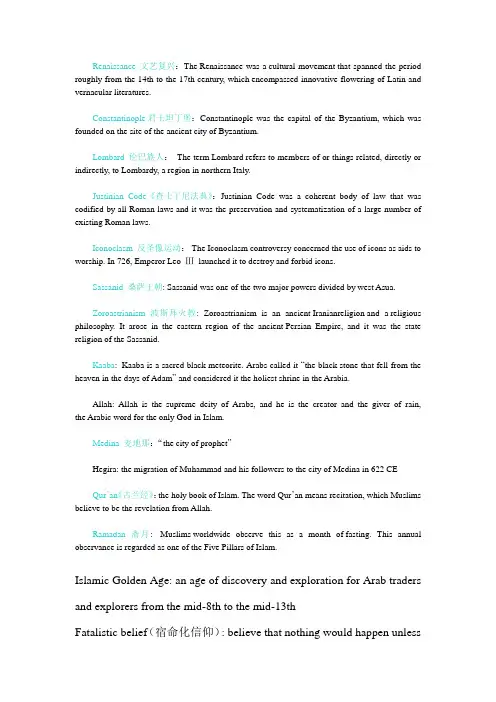
Renaissance 文艺复兴:The Renaissance was a cultural movement that spanned the period roughly from the 14th to the 17th century, which encompassed innovative flowering of Latin and vernacular literatures.Constantinople君士坦丁堡:Constantinople was the capital of the Byzantium, which was founded on the site of the ancient city of Byzantium.Lombard 伦巴族人:The term Lombard refers to members of or things related, directly or indirectly, to Lombardy, a region in northern Italy.Justinian Code《查士丁尼法典》:Justinian Code was a coherent body of law that was codified by all Roman laws and it was the preservation and systematization of a large number of existing Roman laws.Iconoclasm 反圣像运动:The Iconoclasm controversy concerned the use of icons as aids to worship. In 726, Emperor Leo Ⅲlaunched it to destroy and forbid icons.Sassanid 桑萨王朝: Sassanid was one of the two major powers divided by west Asua.Zoroastrianism 波斯拜火教: Zoroastrianism is an ancient Iranianreligion and a religious philosophy. It arose in the eastern region of the ancient Persian Empire, and it was the state religion of the Sassanid.Kaaba: K aaba is a sacred black meteorite. Arabs called it “the black stone that fell from the heaven in the days of Adam” and considered it the holiest shrine in the Arabia.Allah: Allah is the supreme deity of Arabs, and he is the creator and the giver of rain, the Arabic word for the only God in Islam.Medina 麦地那:“the city of prophet”Hegira: the migration of Muhammad and his followers to the city of Medina in 622 CEQur’an《古兰经》:the holy book of Islam. The word Qur’an means recitation, which Muslims believe to be the revelation from Allah.Ramadan 斋月: Muslims worldwide observe this as a month of fasting. This annual observance is regarded as one of the Five Pillars of Islam.Islamic Golden Age: an age of discovery and exploration for Arab traders and explorers from the mid-8th to the mid-13thFatalistic belief(宿命化信仰): believe that nothing would happen unlessthe God actively willed itKnowledge of Truth: it is not just knowledge, rather, it is "epi - gnosis"(from the Internet and can not find a exact definition)Arab numeral system(阿拉伯数字体系): a system that log with Latin numberArabian Nights(一千零一夜): also called The Book of One Thousands and One Nights, mostly a compilation of earlier folk tales.Feudalism(封建制度): the social system that developed in Europe in the 8th century; vassals were protected by lords who they had to serve in war Charlemagne(查理曼大帝): (also called Charles the Great) the greatest Frankish king who established the vast Carolingian EmpireCarolus Magnus: the Latin version of Charlemagne’s nameVassal(封臣): a person holding a fief; a person who owes allegiance and service to a feudal lordCounty(郡): distinct similar to the Roman ProvinceCount(伯爵): the administrator, judge and military leader of the county Clergy(什一税): 10% income taxDark Ages: the two centuries after Carolingian Empire collapsed which Western Europe being attached by non-Christian invadersTribute(贡金):money that forced to pay to the invaders after being occupiedNormandy(诺曼底): (also called “land of Norse”) the part of the northern Frankish coastal region which under Norseman’s control in 911 Vassalage(采邑制,封臣制): the relationship between a vassal and his lordCrusader(十字军):a warrior who engages in a holy warTreaty of Verdun(凡尔登条约): a treaty that divided the Carolingian Empire into three parts in 843, signed by Louis the PiousTreaty of Meerssen(莫尔森条约): a treaty signed in 870 that ended the civil war between the East Franks and the West Franks。
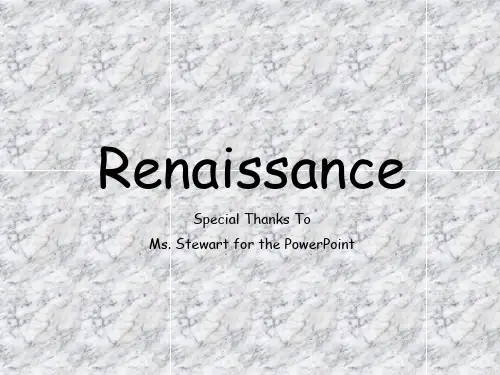
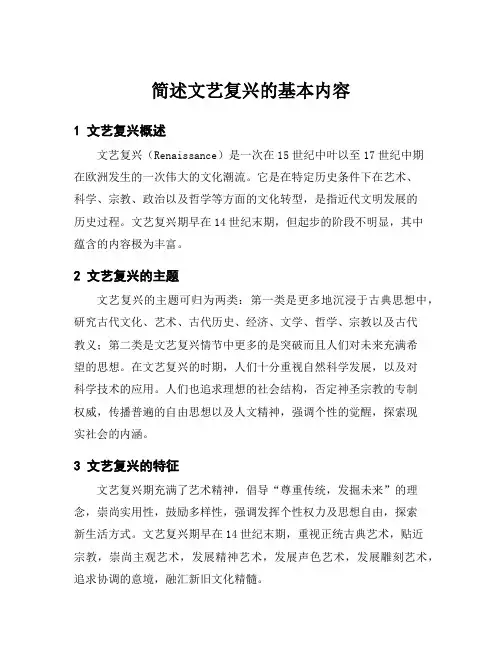
简述文艺复兴的基本内容
1 文艺复兴概述
文艺复兴(Renaissance)是一次在15世纪中叶以至17世纪中期
在欧洲发生的一次伟大的文化潮流。
它是在特定历史条件下在艺术、
科学、宗教、政治以及哲学等方面的文化转型,是指近代文明发展的
历史过程。
文艺复兴期早在14世纪末期,但起步的阶段不明显,其中
蕴含的内容极为丰富。
2 文艺复兴的主题
文艺复兴的主题可归为两类:第一类是更多地沉浸于古典思想中,研究古代文化、艺术、古代历史、经济、文学、哲学、宗教以及古代
教义;第二类是文艺复兴情节中更多的是突破而且人们对未来充满希
望的思想。
在文艺复兴的时期,人们十分重视自然科学发展,以及对
科学技术的应用。
人们也追求理想的社会结构,否定神圣宗教的专制
权威,传播普遍的自由思想以及人文精神,强调个性的觉醒,探索现
实社会的内涵。
3 文艺复兴的特征
文艺复兴期充满了艺术精神,倡导“尊重传统,发掘未来”的理念,崇尚实用性,鼓励多样性,强调发挥个性权力及思想自由,探索
新生活方式。
文艺复兴期早在14世纪末期,重视正统古典艺术,贴近
宗教,崇尚主观艺术,发展精神艺术,发展声色艺术,发展雕刻艺术,追求协调的意境,融汇新旧文化精髓。
4 文艺复兴的意义
文艺复兴期间发生的文化材料及艺术表现,它们不只是单纯的艺术形式,更多的是表达了现代艺术的思想意义以及文化价值。
文艺复兴的精神极大地激励了人类的精神追求,令社会迈向新的文化路径。
文艺复兴也使欧洲文化走向繁荣,科学和社会有了大革新,最重要的是人们发展了一个向外看的视野,特别是全球思维的实践,也为人类走向现代文明路径铺了基础。
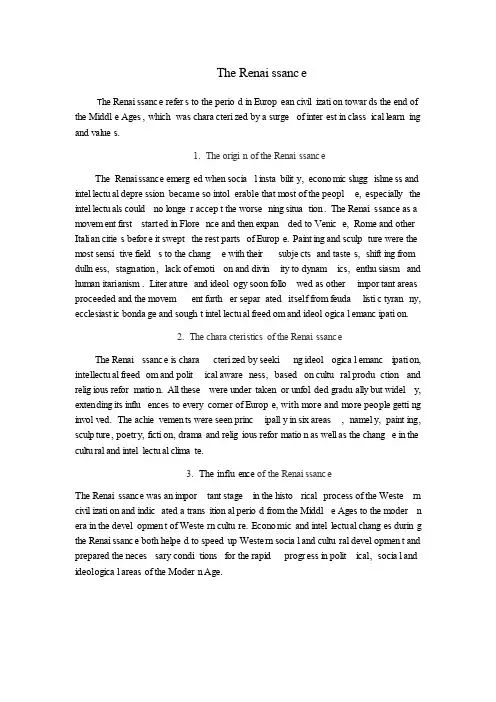
The Renais sanceT he Renais sance refers to the period in Europe an civili zatio n toward s the end of the Middle Ages, whichwas charac teriz ed by a surgeof intere st in classi cal learni ng and values.1.The origin of the Renais sanceThe Renais sance emerge d when social instab ility, econom ic sluggi shnes s and intell ectua l depres sionbecame so intole rable that most of the people, especi allythe intell ectua ls couldno longer accept the worsen ing situat ion. The Renais sance as a moveme nt firststarte d in Floren ce and then expand ed to Venice, Rome and otherItalia n cities before it sweptthe rest partsof Europe. Painti ng and sculpt ure were the most sensit ive fields to the change with theirsubjec ts and tastes, shifti ng from dullne ss, stagna tion,lack of emotio n and divini ty to dynami cs, enthus iasmand humani taria nism.Litera tureand ideolo gy soon follow ed as otherimport ant areasprocee ded and the moveme nt furthe r separa ted itself from feudal istic tyrann y, eccles iasti c bondag e and sought intell ectua l freedo m and ideolo gical emanci patio n.2.The charac teris ticsof the Renais sanceThe Renais sance is charac teriz ed by seekin g ideolo gical emanci patio n, intell ectua l freedo m and politi cal awaren ess, basedon cultur al produc tionand religi ous reform ation. All thesewere undert akenor unfold ed gradua lly but widely, extend ing its influe ncesto everycorner of Europe, with more and more people gettin g involv ed. The achiev ement s were seen princi pally in six areas,namely, painti ng, sculpt ure, poetry, fictio n, dramaand religi ous reform ation as well as the change in the cultur al and intell ectua l climat e.3.The influen ce of the Renais sanceThe Renais sance was an import ant stagein the histor icalproces s of the Wester n civili zatio n and indica ted a transi tiona l period from the Middle Ages to the modern era in the develo pment of Wester n cultur e. Econom ic and intell ectua l change s during the Renais sance both helped to speedup Wester n social and cultur al develo pment and prepar ed the necess ary condit ionsfor the rapidprogre ss in politi cal, social and ideolo gical areasof the Modern Age.文艺复兴是指由于意大利最早产生了资本主义萌芽,13世纪末在意大利兴起,以后扩散到西欧各国,16世纪盛行的一场思想文化运动。

Renaissance 文艺复兴※Renaissance means “rebirth” and refers to a period in the development of Western art and culture beginning in 1300 and ending in 1600. It was a time of rediscovery, ambition and change, dominated by a number of trends and contradictions. It is usually associated with Italy, in particular Florence, Venice and Rome, but Northern Europe also contributed to the Renaissance, particularly in the development of Naturalism.文艺复兴意为重生,源自公元1300年和1600年之间西方艺术和文化大发展时期。
这是一个重新发现、渴求和变革的时期,漫溢着无数潮流和矛盾,通常认为与意大利,尤其是翡冷翠,威尼斯和罗马息息相关,但北欧对于文艺复兴,特别是自然主义的贡献也不可小觑。
※KEY WORDS:Order; symmetry; perspective; classical; space; movement 关键词:秩序;对称性;透视;古典;空间;动感※The Renaissance witnessed a ”rebirth” of interest in the classical past in which individuals, rather than academic institutions, took the lead. The study of ancient Greece and Rome was central to Renaissance Humanism. This is a broad, philosophical trend in which questions abouthuman relationships (social, religious and political) are answered by the use of reason and reflection on experience, rather than by reference to spiritual authorities. The central, immensely ambitious, and ultimately self-contradictory project of the Renaissance was the synthesis of Classical, or Humanist, values with Christianity. Giorgio Vasari, author of the Lives of the most Excellent Italian artists, Painters and Sculptors (1550 and 1568) thought that Renaissance artists had excelled the Classical past because they had achieved this union.文艺复兴见证了过往古典主义审美意趣的再生,彼时个体相对于学院派的研究更具领导地位。
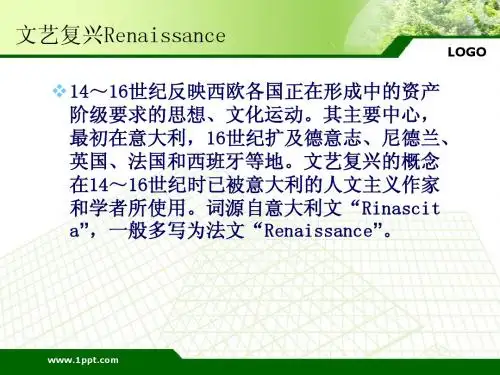
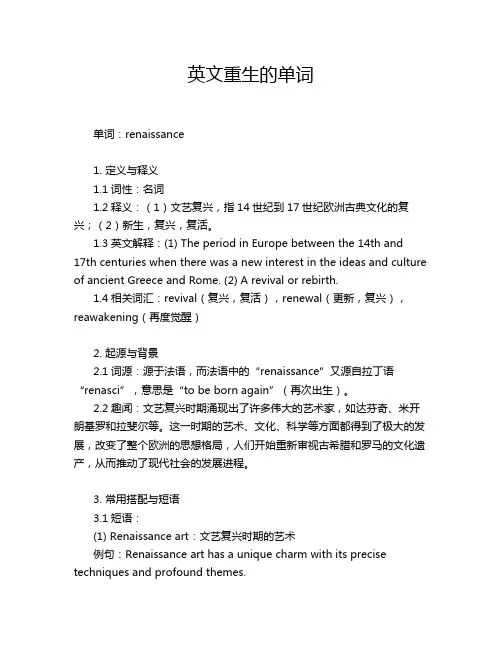
英文重生的单词单词:renaissance1. 定义与释义1.1词性:名词1.2释义:(1)文艺复兴,指14世纪到17世纪欧洲古典文化的复兴;(2)新生,复兴,复活。
1.3英文解释:(1) The period in Europe between the 14th and17th centuries when there was a new interest in the ideas and culture of ancient Greece and Rome. (2) A revival or rebirth.1.4相关词汇:revival(复兴,复活),renewal(更新,复兴),reawakening(再度觉醒)2. 起源与背景2.1词源:源于法语,而法语中的“renaissance”又源自拉丁语“renasci”,意思是“to be born again”(再次出生)。
2.2趣闻:文艺复兴时期涌现出了许多伟大的艺术家,如达芬奇、米开朗基罗和拉斐尔等。
这一时期的艺术、文化、科学等方面都得到了极大的发展,改变了整个欧洲的思想格局,人们开始重新审视古希腊和罗马的文化遗产,从而推动了现代社会的发展进程。
3. 常用搭配与短语3.1短语:(1) Renaissance art:文艺复兴时期的艺术例句:Renaissance art has a unique charm with its precise techniques and profound themes.翻译:文艺复兴时期的艺术以其精湛的技艺和深刻的主题有着独特的魅力。
(2) Renaissance man:多才多艺的人例句:Leonardo da Vinci is often regarded as a Renaissance man because of his wide range of knowledge and skills.翻译:列奥纳多·达·芬奇因其广泛的知识和技能常被视为一个多才多艺的人。
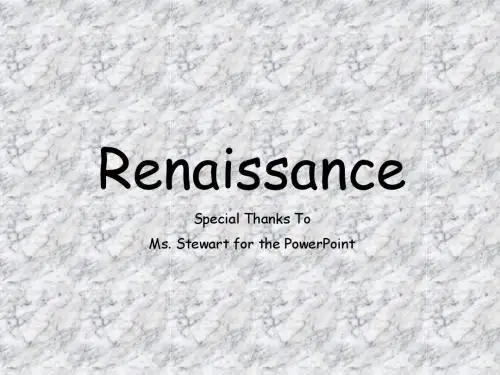
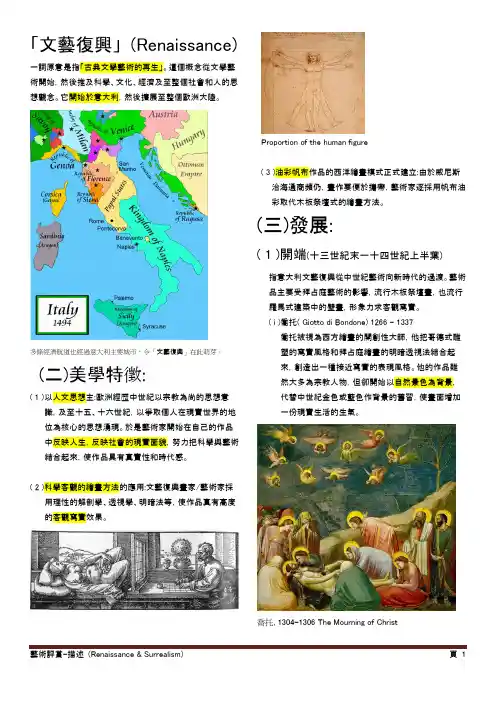
「文藝復興」(Renaissance) 一詞原意是指「古典文學藝術的再生」。
這個概念從文學藝術開始,然後推及科學、文化、經濟及至整個社會和人的思想觀念。
它開始於意大利,然後擴展至整個歐洲大陸。
多條經濟航道也經過意大利主要城市,令「文藝復興」在此萌芽。
(二)美學特徵:( 1 )以人文思想主:歐洲經歷中世紀以宗教為尚的思想意識,及至十五、十六世紀,以爭取個人在現實世界的地位為核心的思想湧現。
於是藝術家開始在自己的作品中反映人生,反映社會的現實面貌,努力把科學與藝術結合起來,使作品具有真實性和時代感。
( 2 )科學客觀的繪畫方法的應用:文藝復興畫家/藝術家採用理性的解剖學、透視學、明暗法等,使作品真有高度的客觀寫實效果。
Proportion of the human figure( 3 )油彩帆布作品的西洋繪畫模式正式建立:由於威尼斯治海通商頻仍,畫作要便於攜帶,藝術家逐採用帆布油彩取代木板祭壇式的繪畫方法。
(三)發展:( 1 )開端(十三世紀末一十四世紀上半葉)指意大利文藝復興從中世紀藝術向新時代的過渡。
藝術品主要受拜占庭藝術的影響,流行木板祭壇畫,也流行羅馬式建築中的壁畫,形象力求客觀寫實。
( i )喬托( Giotto di Bondone) 1266 – 1337喬托被視為西方繪畫的開創性大師,他把哥德式雕塑的寫實風格和拜占庭繪畫的明暗透視法結合起來,創造出一種接近寫實的表現風格。
他的作品雖然大多為宗教人物,但卻開始以自然景色為背景,代替中世紀金色或藍色作背景的舊習,使畫面增加一份現實生活的生氣。
喬托, 1304-1306 The Mourning of Christ( 2 )早期(十五世紀,佛羅倫薩及北意大利)在銀行家柯西莫。
美迪奇的支持下,佛羅倫薩的藝術得以繁榮發展。
其時大量古希臘、羅馬文化古跡的考古發掘;及希臘的哲學書籍的手抄本流入意大利,使藝術家意識到藝術與科學的結合。
研究人體的解剖結構、研究 科學的透視法和明暗法,探討各種造形藝術的技法理論,成為當時藝術的風尚。
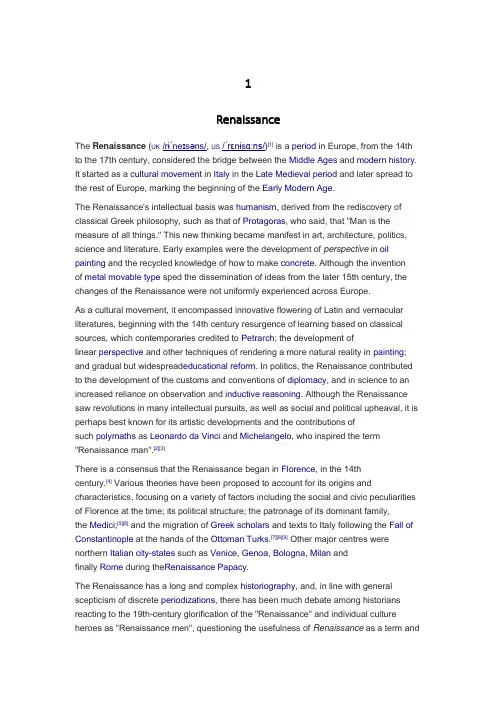
1RenaissanceThe Renaissance (UK/rɨˈneɪsəns/, US/ˈrɛnɨsɑːns/)[1] is a period in Europe, from the 14th to the 17th century, considered the bridge between the Middle Ages and modern history. It started as a cultural movement in Italy in the Late Medieval period and later spread to the rest of Europe, marking the beginning of the Early Modern Age.The Renaissance's intellectual basis was humanism, derived from the rediscovery of classical Greek philosophy, such as that of Protagoras, who said, that "Man is the measure of all things." This new thinking became manifest in art, architecture, politics, science and literature. Early examples were the development of perspective in oil painting and the recycled knowledge of how to make concrete. Although the inventionof metal movable type sped the dissemination of ideas from the later 15th century, the changes of the Renaissance were not uniformly experienced across Europe.As a cultural movement, it encompassed innovative flowering of Latin and vernacular literatures, beginning with the 14th century resurgence of learning based on classical sources, which contemporaries credited to Petrarch; the development oflinear perspective and other techniques of rendering a more natural reality in painting; and gradual but widespread educational reform. In politics, the Renaissance contributed to the development of the customs and conventions of diplomacy, and in science to an increased reliance on observation and inductive reasoning. Although the Renaissance saw revolutions in many intellectual pursuits, as well as social and political upheaval, it is perhaps best known for its artistic developments and the contributions ofsuch polymaths as Leonardo da Vinci and Michelangelo, who inspired the term "Renaissance man".[2][3]There is a consensus that the Renaissance began in Florence, in the 14thcentury.[4] Various theories have been proposed to account for its origins and characteristics, focusing on a variety of factors including the social and civic peculiarities of Florence at the time; its political structure; the patronage of its dominant family,the Medici;[5][6] and the migration of Greek scholars and texts to Italy following the Fall of Constantinople at the hands of the Ottoman Turks.[7][8][9] Other major centres were northern Italian city-states such as Venice, Genoa, Bologna, Milan andfinally Rome during the Renaissance Papacy.The Renaissance has a long and complex historiography, and, in line with general scepticism of discrete periodizations, there has been much debate among historians reacting to the 19th-century glorification of the "Renaissance" and individual culture heroes as "Renaissance men", questioning the usefulness of Renaissance as a term andas a historical delineation.[10] The art historian Erwin Panofsky observed of this resistance to the concept of "Renaissance":It is perhaps no accident that the factuality of the Italian Renaissance has been most vigorously questioned by those who are not obliged to take a professional interest in the aesthetic aspects of civilization—historians of economic and social developments, political and religious situations, and, most particularly, natural science—but only exceptionally by students of literature and hardly ever by historians of Art.[11]Some observers have called into question whether the Renaissance was a cultural "advance" from the Middle Ages, instead seeing it as a period of pessimismand nostalgia for classical antiquity,[12] while social and economic historians, especially of the longue durée, have instead focused on the continuity between the two eras[13] which are linked, as Panofsky himself observed, "by a thousand ties".[14]The word Renaissance, literally meaning "Rebirth" in French, first appears in English in the 1830s.[15] The word occurs in Jules Michelet's 1855 work, Histoire de France. The word Renaissance has also been extended to other historical and cultural movements, such as the Carolingian Renaissance and the Renaissance of the 12th century.[16]2RepresentativesAlfred Tennyson, among many others. In addition, the first use of the interlockingthree-line rhyme scheme, or the terza rima, is attributed to him.Dante has been called "the Father of the Italian language".[2] In Italy, Dante is often referred to as il Sommo Poeta("the Supreme Poet") and il Poeta; he, Petrarch, and Boccaccio are also called "the three fountains" or "the three crowns".The Divine Comedy describes Dante's journeythrough Hell (Inferno), Purgatory (Purgatorio), and Paradise (Paradiso)Dante, like most Florentines of his day, was embroiled in the Guelph–Ghibelline conflict. He fought in the Battle of Campaldino (June 11, 1289), with the Florentine Guelphs against Arezzo Ghibellines; then in 1294 he was among the escorts of Charles Martel of Anjou (grandson of Charles I of Naples, more commonly called Charles of Anjou) while he was in Florence. To further his political career, he became a pharmacist. He did not intend to practice as one, but a law issued in 1295 required nobles aspiring to public office to be enrolled in one of the CorporazionidelleArti e deiMestieri, so Dante obtained admission to the Apothecaries' Guild. This profession was not inappropriate, since at that time books were sold from apothecaries' shops. As a politician he accomplished little, but held various offices over some years in a city rife with political unrest.After defeating the Ghibellines, the Guelphs divided into two factions: the White Guelphs (Guelfi Bianchi)—Dante's party, led by VierideiCerchi—and the Black Guelphs (GuelfiNeri), led by Corso Donati. Although the split was along family lines at first, ideological differences arose based on opposing views of the papal role in Florentine affairs, with the Blacks supporting the Pope and the Whites wanting more freedom from Rome. The Whites took power first and expelled the Blacks. In response, Pope Boniface VIII planned a military occupation of Florence. In 1301, Charles of Valois, brother ofKing Philip IV of France, was expected to visit Florence because the Pope had appointed him peacemaker for Tuscany. But the city's government had treated the Pope's ambassadors badly a few weeks before, seeking independence from papal influence. It was believed that Charles had received other unofficial instructions, so the council sent a delegation to Rome to ascertain the Pope's intentions. Dante was one of the delegates.2. Leonardo da Vinci。
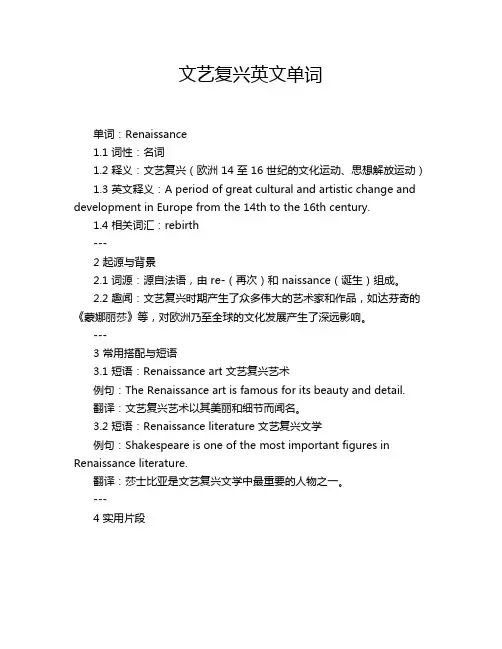
文艺复兴英文单词单词:Renaissance1.1 词性:名词1.2 释义:文艺复兴(欧洲 14 至 16 世纪的文化运动、思想解放运动)1.3 英文释义:A period of great cultural and artistic change and development in Europe from the 14th to the 16th century.1.4 相关词汇:rebirth---2 起源与背景2.1 词源:源自法语,由 re-(再次)和 naissance(诞生)组成。
2.2 趣闻:文艺复兴时期产生了众多伟大的艺术家和作品,如达芬奇的《蒙娜丽莎》等,对欧洲乃至全球的文化发展产生了深远影响。
---3 常用搭配与短语3.1 短语:Renaissance art 文艺复兴艺术例句:The Renaissance art is famous for its beauty and detail.翻译:文艺复兴艺术以其美丽和细节而闻名。
3.2 短语:Renaissance literature 文艺复兴文学例句:Shakespeare is one of the most important figures in Renaissance literature.翻译:莎士比亚是文艺复兴文学中最重要的人物之一。
---4 实用片段(1) "I'm studying the Renaissance period in history class. It's so fascinating to learn about the great thinkers and artists of that time." said Tom. "Yes, the Renaissance was a time of great innovation and creativity." replied the teacher.翻译:“我在历史课上学习文艺复兴时期。
文艺冷僻的英文单词1.小说: novel 小说家: novelist2.散文: essay3.诗歌: poem 诗人: poet4.文艺复兴: Renaissance5.游记: book of travels6.报告文学:reportage7.畅销书: best seller8.选集: anthology9.版: copyright10.版权, 著作权: edition, printing11.精装: deluxe binding12.平装: flat stitching13.线装: smyth sewed14.戏剧: drama 喜剧:comedy 悲剧:tragedy 滑稽剧:farce15.古典文学: classical literature16.Curtain 落幕17.Allure Love 倾城恋18.Tenderness 温存19.Flowers 繁花【外国人眼中5个最美英文单词】Petrichor 初雨的气息A pleasant smell that frequently accompanies the first rain after a long period of warm, dry weather。
很长一段温暖、干燥的天气后,第一场雨带来的清香。
petrichor,这个单词的英文释义那么美,可是如果查有道词典的话会显示是“潮土油”这么low又费解的词义。
为什么?词根petr-表石头,太多西方人的教名Peter其实就是“磐石”之意,再如petroleum石油。
而-ichor则是希腊神话中神仙体内流淌的“神液”,即神的血液。
希腊神话中青铜巨人[微博]Talos塔罗斯全身青铜铸就,所向无敌。
只有一根血管,从颈部通下,其内流淌着ichor直到膝盖处以铜钮遮掩。
阿尔戈号船员取得金羊毛后要在Talos所在的岛屿登陆,Talos阻止时被Medea拔掉了铜纽,金黄色的ichor流淌了满地而死。
文艺复兴运动
艺复兴(Renaissance)是指发生在14世纪到16世纪的一场反映新兴资产阶级要求的欧洲思想文化运动。
“文艺复兴”的概念在14-16世纪时已被意大利的人文主义作家和学者所使用。
当时的人们认为,文艺在希腊、罗马古典时代曾高度繁荣,但在中世纪“黑暗时代”却衰败湮没,直到14世纪后才获得“再生”与“复兴”,因此称为“文艺复兴”。
文艺复兴最先在意大利各城邦兴起,以后扩展到西欧各国,于16世纪达到顶峰,带来一段科学与艺术革命时期,揭开了近代欧洲历史的序幕,被认为是中古时代和近代的分界。
文艺复兴是西欧近代三大思想解放运动(文艺复兴、宗教改革与启蒙运动)之一。